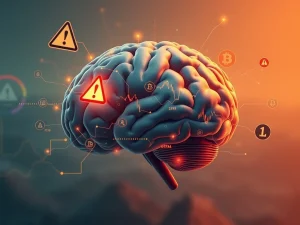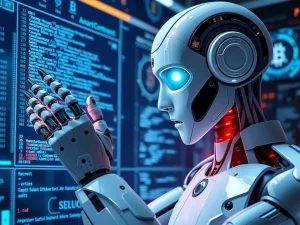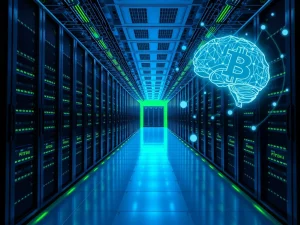Coinbase AI: Brian Armstrong’s Ambitious Drive for 50% Code Generation by October

Coinbase, a leading cryptocurrency exchange, is rapidly integrating artificial intelligence into its core operations. This strategic move is spearheaded by CEO Brian Armstrong, who recently revealed an ambitious target: AI should write 50% of the platform’s code by October. This goal signifies a pivotal shift in how technology companies approach software development. It also highlights the growing influence of artificial intelligence in the crypto sector.
Coinbase AI: Revolutionizing Code Development
Brian Armstrong announced a significant milestone for Coinbase’s engineering efforts. Over 40% of the lines of code contributing to Coinbase’s systems are now written by artificial intelligence. This figure represents a remarkable increase, more than doubling since April. Armstrong expressed his optimism, stating his hope for this percentage to reach 50% by next month. He emphasized the importance of responsible AI use. Armstrong stated, “Obviously it needs to be reviewed and understood, and not all areas of the business can use AI-generated code. But we should be using it responsibly as much as we possibly can.” This statement underscores a balanced approach to technological adoption.
The chart shared by Armstrong visually depicted this rapid acceleration. It showed the percentage of AI-generated code at Coinbase has indeed more than doubled in just a few months. This rapid integration follows Coinbase’s broader initiative to transform its workforce into “AI-Natives.” The company previously clarified it does not intend to replace a significant portion of its 4,200 employees with AI. Instead, it aims to enhance human capabilities through intelligent tools.
The Impact of AI Code Generation on Engineering
Coinbase engineers actively use advanced AI-powered coding tools. These include Copilot, Claude Code, and Cursor. Such tools are streamlining their workflows significantly. This integration has led to profound success stories. These were simply not possible just 12 months ago. For instance, single engineers now refactor, upgrade, or build new codebases in days, not months. This efficiency gain is a game-changer for development cycles.
The increased integration of AI into the workforce has sparked widespread fears about job displacement. However, many experts criticize these gloomy predictions. David Sacks, the White House’s AI and crypto czar, and researchers at PwC argue that the AI job loss narrative is overhyped. They suggest AI will instead boost employee productivity. This perspective aligns with Coinbase’s strategy, focusing on augmentation rather than replacement. The company sees AI as a powerful assistant, not a substitute, for its skilled workforce.
Brian Armstrong’s Stance on AI Adoption
Coinbase CEO Brian Armstrong has taken a firm stance on AI adoption within his company. He recently shared a controversial anecdote on John Collison’s “Cheeky Pint” podcast. Armstrong recounted firing engineers who could not provide a valid reason for not integrating AI into their daily work. This occurred just a week after he posted a mandate in one of Coinbase’s Slack channels, demanding engineers start using AI. This decisive action highlights Armstrong’s conviction regarding AI’s transformative potential.
Armstrong believes AI tools are essential for modern engineering. He champions a culture where AI is not an option but a core component of efficiency. His vision is clear: Coinbase must leverage AI responsibly and extensively. This approach aims to maximize productivity and innovation across the platform. His leadership pushes the boundaries of traditional software development, setting a precedent for other tech giants.
Navigating Crypto Engineering Jobs in an AI Era
Despite the significant push for AI integration, Coinbase continues to hire aggressively. The company is particularly focused on its engineering and development departments. Nearly half of its approximately 350 current job openings seek hard-skilled professionals. Specifically, 93 roles are for backend engineering, with many referencing AI in the job title or description. This trend suggests a shift in required skills, favoring those who can work alongside AI.
Customer experience roles also remain a high priority, with 56 openings. This indicates that human interaction and support are still crucial, even with increased automation. While large-scale layoffs have eased across the crypto market, industry recruiters note a tightening in crypto hiring since 2022. They largely attribute this to AI diverting talent and capital away from the sector. Raman Shalupau and Stefi Kiemeney of CryptoJobsList observed, “Developers and entrepreneurs follow the money and excitement, and right now AI is soaking up both.” This reflects a broader industry trend where AI is becoming the new frontier for innovation and investment.
The Future of AI in Crypto and Beyond
The integration of AI in crypto platforms like Coinbase marks a significant evolution for the digital asset space. This move transcends mere automation; it represents a fundamental rethinking of how software is built and maintained. AI is not just writing code; it is enabling single engineers to tackle projects that previously required entire teams and months of effort. This newfound efficiency could dramatically accelerate development cycles and reduce time-to-market for new features and products within the crypto ecosystem.
The long-term implications are profound. As AI tools become more sophisticated, they will likely redefine the roles of software engineers, emphasizing oversight, strategic thinking, and complex problem-solving over routine coding tasks. Coinbase’s bold target of 50% AI-generated code by October positions it at the forefront of this technological revolution. This approach could inspire other crypto companies to embrace AI more fully, fostering an environment of rapid innovation and efficiency. The ongoing blend of human expertise and artificial intelligence promises a more robust and dynamic future for the entire cryptocurrency industry.









